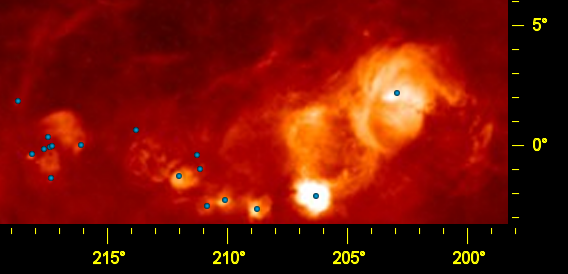
Hover your mouse over each blue dot for the name of the object, or click on the dot for a detail page. This map was created using the all-sky hydrogen-alpha map produced by Douglas Finkbeiner from data collected by the WHAM, VTSS and SHASSA hydrogen-alpha surveys.
This region is dominated in hydrogen-alpha by nebulae associated with two OB associations in the direction of the constellation Monoceros. The Fox Fur nebula (Sh 2-273) is associated with Mon OB1. This association contains the core star cluster NGC 2264 at 800 parsecs, which is dominated by the O7Ve multiple star system S Mon. The famous Cone nebula is part of the larger Fox Fur nebula.
The Rosette Nebula (Sh 2-275), one of the most beautiful sights in the Milky Way, is associated with Mon OB2. This association contains the core star cluster NGC 2244, which lies near the center of the 160 thousand solar mass Rosette giant molecular cloud at 1600 parsecs. NGC 2244 contains 4 OV class stars and another 13 B0-3 V class stars. The Rosette molecular cloud also contains two other prominent nebulae: Sh 2-280 and Sh 2-282. Visible in to the north of the Rosette nebula and apparently physically associated with it is the Monoceros Loop supernova remnant (SNR 205.5+00.5). BFS 54 may also be associated with the Rosette molecular cloud (but see below).
To the east (left on this image) are a number of smaller nebulae at a wide variety of distances. Sh 2-283 is located at 9100 parsecs. Sh 2-284 is a Rosette-like nebula surrounding the star cluster Dolidze 25 at a distance of 5200 parsecs. To the northwest of Sh 2-284 are BFS 53 at a distance of 1900 parsecs and BFS 54 at 8700 parsecs, which SIMBAD identifies as the reflection nebula NGC 2282 (Vdb 85). As the distance to this reflection nebula has been estimated to be only 1700 parsecs, either there are two distinct objects in this direction or the molecular gas associated with this nebula has been highly disturbed and so is providing an incorrect (too large) distance estimate. Another prominent nebula on the left side of the image, also at 1700 parsecs, is BFS 55, which oddly has no significant references in the scientific literature. Between Sh 2-284 and BFS 55 is the HII region Sh 2-285 which is ionised by two B0V stars and is believed to lie at a distance of 6900 parsecs.
Left (east) of BFS 55 is a complex of three small nebulae located at a distance of 2400 parsecs: BFS 57, BFS 58 and BFS 59. Slightly further west than this is Sh 2-287 which appears to be related to the 4-5000 solar mass Maddalena's molecular cloud. South of these nebulae is the HII region Sh 2-286 at 6600 parsecs, which contains the infrared cluster [BDS2003] 88. North is Sh 2-288 (IC 466) at 3000 parsecs. Sharpless has recorded Sh 2-288 as a tiny nebula but in hydrogen-alpha it appears to be associated with a long faint ridge of nebulosity at the upper left of this image.
